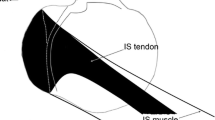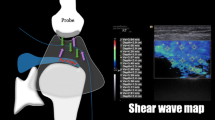Summary
The aim of this study was to attempt to specify the nature of the signal modifications observed in MRI in the supraspinatus tendon apart from any pathology of the shoulder, and due, according to certain authors, to an artefact associated with MRI. Five macroscopically normal supraspinatus tendons were removed from 4 young subjects (14–28 years), 30 min after cardiac arrest, with the authorisation of the ethical committee. These tendons were examined by MRI in the frontal oblique plane along the axis of the muscle with a surface coil of 4 cm diameter, using a T2-weighted spin-echo sequence, and then studied histologically using the same plane of section. 22 control subjects (18–24 years) were examined by MRI with the same T2-weighted spinecho sequence. All the tendons examined possessed a dark signal with zones of intermediate signal on the first echo of the sequence. There was a complete correlation between the MRI appearances of the 5 tendons and their histologic description. Three histologic appearances were described: fibrillary degeneration, fibrous dystrophy, and eosinophil transformation of the tendinous collagen. All the tendons examined in healthy volunteers exhibited hetereogenic images at the first echo; in the second echo the hyposignal was uniform and obvious. The good correlation obtained suggests that modifications of the tendon signal from the supraspinatus m. are not related to an artefact described in MRI, but are linked with premature degeneration of this tendon, probably associated with the severity of the mechanical constraints to which it is subject.
Résumé
Le but du travail était d'essayer de préciser la nature des modifications de signal observées en IRM dans le tendon du m. supra-épineux en dehors de toute pathologie de l'épaule, et dûes, selon certains auteurs, à un artefact lié à l'IRM. Cinq tendons macroscopiquement normaux de m. supra-épineux ont été prélevés chez 4 patients jeunes (14 à 28 ans), 30 mn maximun après l'arrêt cardiaque, après autorisation du comité d'éthique. Ces tendons ont été examinés en IRM dans le plan frontal oblique suivant l'axe du muscle avec une antenne de surface de 4 cm de diamètre en utilisant une séquence écho de spin T2, puis ont été analysés en histologie en utilisant le même plan de coupe. Vingt-cinq sujets témoins (18 à 34 ans) ont été examinés en IRM avec la même séquence écho de spin T2. Tous les tendons de m. supra-épineux examinés possédaient un signal noir avec des zones de signal intermédiaire sur le premier écho de la séquence. Il existait une parfaite corrélation entre l'aspect en IRM des 5 tendons prélevés et leur description en histologie. Trois aspects histologiques ont été décrit: dégénérescence fibrillaire, dystrophie fibreuse, transformation éosinophile du collagène tendineux. Tous les tendons examinés chez les volontaires sains présentaient, au premier écho, des images hétérogènes; au second écho, l'hyposignal était homogène et franc. La bonne corrélation obtenue permet de suggérer que les modifications du signal du tendon du m. supra-épineux ne sont pas en rapport avec un artéfact décrit en IRM mais sont liés à une détérioration précoce de ce tendon, vraisemblablement liée à l'importance des contraintes mécaniques qu'il subit.
Similar content being viewed by others
References
Bittoun J, Saint James H, Quelleux BG et al (1990) In vivo high resolution MR imaging of the skin in a whole body system at 1.5T. Radiology 176: 457–460
Codamn EA, Akerson IB (1931) The pathology associated with rupture of the supraspinatus tendon. Ann Surg 93: 348–359
Cofield RH (1985) Current concepts review: rotator cuff disease of the shoulder. J Bone Joint Surg [Am] 67-A: 994–999
Davis SJ, Teresi LM, Bradley WG et al (1991) Effect of arm rotation on MR imaging of the rotator cuff. Radiology 181: 265–268
Erickson SJ, Cox IH, Hyde JS et Al (1991) Effect of tendon orientation on MR imaging signal intensity: a manifestation of the “magic angle” phenomenon. Radiology 181: 389–392
Fullerton GD, Cameron IL, Ord VA (1985) Orientation of tendons in the magnetic field and its effect on the relaxation times. Radiology 155: 433–435
Gagey N, Ravaud E, Lassau JP (1993) Anatomy of the coracoacromial arch: correlation of anatomy and magnetic resonance imaging. Surg Radiol Anat 15: 63–70
Gagey N, Gagey O, Bastian D, Lassau JP (1990) The fibrous frame of the supraspinatus muscle. Surg Radiol Anat 12: 291–292
Kjellin I, Ho CP, Cervilla V et Al (1991) Alterations in the supraspinatus tendon at MR imaging: correlation with histopathologic findings in cadavers. Radiology 181: 837–841
Lindblom K (1939) On pathogenesis of ruptures of the tendon aponeurosis of the shoulder joint. Acta Radiol 20: 563–577
Ling SC, Chen CF, Wan RX (1990) A study on the vascular supply of the supraspinatus tendon. Surg Radiol Anat 12: 161–165
Liou JTS, Wilson AJ, Totty WG, Brown JJ. (1993) The normal shoulder: common variations that simulate pathologic conditions at MR imaging. Radiology 186: 435–441
Mirovitz SA (1991) Normal rotator cuff MR imaging with conventional and fat suppression techniques. Radiology 180: 735–740
Moseley HF, Goldie I (1963) The arterial pattern of the rotator cuff of the shoulder. J Bone Joint Surg [Br] 45-B: 780–789
Neer CS (1972) Anterior acromioplasty for the chronic impingement syndrome in the shoulder. Preliminary report. J Bone Joint Surg [Am] 54-A: 41–50
Rafii M, Firooznia H, Sherman O et Al (1990) Rotator cuff lesions: signal patterns at MR imaging. Radiology 177: 817–823
Rathburn JB, Macnab I (1970) The microvascular pattern of the rotator cuff. J Bone Joint Surg [Br] 52-B: 540–553
Author information
Authors and Affiliations
Rights and permissions
About this article
Cite this article
Gagey, N., Quillard, J., Gagey, O. et al. Tendon of the normal supraspinatus muscle: correlations between MR imaging and histology. Surg Radiol Anat 17, 329–334 (1995). https://doi.org/10.1007/BF01795192
Received:
Revised:
Accepted:
Issue Date:
DOI: https://doi.org/10.1007/BF01795192




